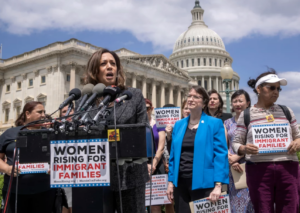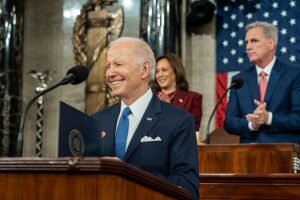Largest Climate Bill in U.S. History Is a Start, but Is It Enough?
Though the IRA has been praised by many both inside and outside of politics, it has also been criticized for a variety of reasons.

Image Credit: Drew Angerer/Getty Images
(NEW YORK) – Met with an enthusiastic round of applause and cheers, US President Joe Biden signed the Inflation Reduction Act (IRA) into law on Aug. 16, 2022. In his address to the American people, Biden triumphantly said the IRA – a bill dedicated to fighting climate change and reducing fossil fuel emissions in a way that will also lower inflation – is one of the most significant laws in American history.
Though the IRA has been praised by many both inside and outside of politics, it has also been criticized for a variety of reasons – namely for its lack of regulations on fossil fuel production and its minimal support of marginalized and low-income communities living on the frontlines of climate change.
“We acknowledge this Act offers some important investments in renewable energy, housing efficiency, and health. However, this legislation predictably sacrifices communities on the frontlines of climate disasters, from the Gulf South to Alaska,” said global climate justice organization Taproot Earth said in a statement released in August.
According to research conducted by the Environmental Protection Agency (EPA), the United States is a major contributor to greenhouse gas emissions, producing over five million metric tons of carbon dioxide in 2020 alone. The majority of these emissions come from the electric and transportation industries. With the passing of the IRA, the federal government is allocating $369 billion – the largest pro-climate law in history – to cut carbon emissions by 40 percent by 2030 and help the country progress toward clean energy.
At a panel hosted by John Hopkins University, Tom Peterson, CEO of the Center for Climate Strategies said the IRA is really about bringing technology into action and encouraging the transition to ‘clean energy’ (energy sources that don’t produce any polluting emissions into the atmosphere when used) on an individual, state and national level.
To encourage these expansions, the IRA offers tax credits to individuals or businesses who transition their homes, vehicles, or energy systems to clean energy sources. So if a homeowner transitions their stove to natural gas or their vehicle to electric, then they are eligible for a tax credit of varying sums.
These incentives not only reduce emissions but they reduce energy costs, which is a major contributor to inflation in the United States, Peterson said.
“It’s estimated that for reasons completely unrelated to climate change, household energy costs will go up enough to possibly put 75 percent of our households into an energy poverty status. The Inflation Reduction is really designed very specifically for that reason,” he said. Energy poverty is when a household must reduce their energy consumption to such a low level that it negatively impacts their health and well-being.
Other important aspects of the bill include a 15 percent tax rate for corporations with at least $1 billion in income, an added extension to the Affordable Care Act, and other investments in climate protection and clean energy initiatives.
Despite these initiatives, the IRA has been criticized for its ‘carrot not stick’ approach. The law heavily relies on providing incentives (carrots) for consumers and companies to move towards clean energy, but very few regulations or punishments (sticks) for companies that continue to emit fossil fuels.
Anthony Rogers-Wright, director of environmental justice at the New York Lawyers Public Interest (NYLPI), says this approach adheres to the unreliable belief that if there is an incentive to build renewable energy, this will lead fossil fuel companies to reduce their emissions. Rogers-Wright points out that the 737-page bill contains several concessions in which fossil fuel companies benefit from renewable energy projects.
One example of this is in section 50265 of the IRA titled “Ensuring Energy Security.” Put simply, it states that wind or solar development on public land may not get approval unless the following two conditions are met: an “onshore lease sale” meaning a quarterly oil and gas lease sale has been made in the 120 days prior to the development’s approval, and there have been at least 2,000,000 acres in quarterly oil and gas leases in the last year.
Other criticisms have come from grassroots environmental organizations who say the IRA doesn’t prioritize low-income and communities of color living on the frontlines of climate change. Many of these organizations are centered around climate justice, which can be defined differently depending on a community’s experiences. But Rogers-Wright says the fundamental idea is there should be no community or groups of people sacrificed – purposely or not – for the production of energy and other climate-related initiatives. It also means recovery efforts from climate disasters, such as hurricanes or flooding, should be just as urgent in Black, Indigenous, and poor-white communities as they are in affluent white communities, he says.
In President Biden’s speech before signing the bill into law, he said the IRA will fight environmental injustice by supporting “frontline and fenceline” communities that have been overburdened with the “legacy of pollution for too long.”
The law includes several grants dedicated to climate justice projects, in accordance with the federal government’s Justice40 initiative. In January 2021, the federal government made it a goal to have “40 percent of the overall benefits of certain Federal investments flow to disadvantaged communities that are marginalized, underserved, and overburdened by pollution.”
Approximately $60 billion of the $369 billion budget is dedicated to climate-justice-related initiatives and grant programs, including $3 billion in block grants (a federal grant which a local authority can allocate to a range of programs) for community-based organizations, 9.7 billion for rural electric cooperatives, and $1.8 billion in grants for projects that address the environmental impacts of transportation infrastructure in “disadvantaged or underserved communities.”
Rogers-Wright says it’s not enough. As other activists have, he points out that $60 billion is not even close to 40 percent of the $369 billion deal. The climate-justice-related investments comprise just over 16 percent of the overall budget. According to research conducted by the Environmental and Energy Law Program at Harvard University, the actual amount designated to climate justice could be even lower – around $50 million.
This makes climate justice communities compete with one another for competitive grants and small amounts of money, Rogers-Wright explains. He specifically mentions the $75 million designated to help with renewable energy products in Indigenous communities in section 50145 of the IRA.
“Not enough right? There are over 400 federally recognized tribes, $75 million, even if distributed equally, is not going to be enough to effectively address this crisis in the context of their specific issues,” Rogers-Wright says.
Marin Scotten is enrolled in the joint Global Journalism and International Relations Program. She studied at Toronto Metropolitan University where she graduated with a B.A. in Journalism in 2021.She is very interested in the global food system and how it intersects with gender, class, race and environmental issues. Through various forms of storytelling, Marin hopes to document the human side of complex issues and challenge the stereotypes historically portrayed in traditional media.






